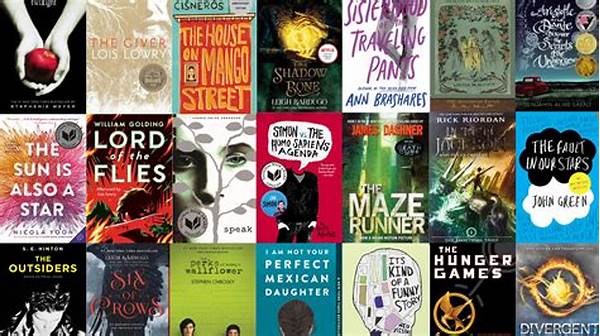Once upon a time, in a universe teeming with stories waiting to be told, there lay the secret art of creating believable character interactions. It wasn’t just about the words characters exchanged, but the unsaid, the energy crackling between them in silence, that turned fictional fantasies into a mirror of reality. Every tale spun by the timeless weavers of narrative whispered this truth: characters must not only speak; they must breathe, react, and live.
Read Now : Dark And Mysterious Literary Devices
The Dance of Dialogue
In the heart of every engaging story lies a tapestry woven from the strands of authentic dialogue and rich interaction. It’s this dance of dialogue that paints characters not merely as players in a plot but as living, breathing entities with aspirations, fears, and flaws. Crafting these interactions demands more than stringing words together. It requires an empathetic ear to the beat of each character’s heart and a sensitive touch to their vulnerabilities.
Creating believable character interactions involves immersing oneself into the world of one’s characters. Imagine a starry night where two characters, once adversaries, find themselves silently contemplating the universe together. The restraint in their words, the spark in their eyes, and the unspoken acknowledgment of shared humanity—this is the artistry of interaction.
These believable exchanges echo with the authenticity of real-life connections, drawing readers into the emotional depths of the narrative. By focusing on the subtleties of human interaction, the storyteller allows the audience to see themselves reflected in the story, blurring the lines between fiction and reality. As each layer of dialogue unfolds, characters emerge not as mere figments of imagination but as reflections of the human condition.
The Craft of Empathetic Characters
1. Understanding motivations is essential for creating believable character interactions. Characters should have clear goals that drive their actions, making their interactions purposeful and compelling.
2. Emotional resonance is key. A character’s feelings should be palpable, giving weight and reality to their conversations and silences.
3. Consistency in behavior fosters believability. A character’s actions and reactions should align with their established persona and growth throughout the narrative.
4. Nuanced conflict is vital. Tension between characters makes interactions lively and reveals deeper layers of their personalities.
5. Genuine connections enrich narratives. Characters should forge realistic relationships that evolve, reflecting life’s complexities and the multifaceted nature of human bonds.
Crafting the Unseen Connections
In the realm of storytelling, creating believable character interactions is akin to painting a masterpiece where each stroke holds the essence of humanity. The storyteller must delve beyond surface-level traits and explore the depths of their characters’ souls. It’s the whispers of the heart and the silent exchanges that add depth to these interactions. Craft is harnessed not just through dialogue but also through a character’s demeanor, their hesitant glances, and their moments of vulnerability.
These nuanced interactions form the backbone of a narrative’s emotional core. When characters interact, it isn’t merely an exchange but a discovery. Each interaction peels back layers, exposing the raw and real emotions beneath. It’s this exploration of the unseen, the quiet ache of longing, the fire of passion, or the sting of betrayal, that turns simple words into a tangible experience. As storytellers, we aspire not just to write lines but to evoke a symphony of emotions, making our characters’ interactions resonate with truth and authenticity.
The Layers of Communication
Characters cease to be mere participants in a story; they become the story. Through creating believable character interactions, they transform their dialogues into a symphonic dance of words and feelings. It is through their laughter, tears, and silences that they convey the richness of the human experience.
1. Listen before writing: Understand your character’s voice and motivations.
2. Reflect real life: Universal experiences make interactions relatable.
3. Develop contradictions: Explore opposing traits for depth.
4. Use subtext: Let unsaid tensions drive the narrative.
Read Now : Tailoring Portfolios For Specific Audiences
5. Embrace evolution: Characters grow and change.
6. Natural rhythms: Dialogue should mimic real conversations.
7. Add imperfections: Flaws make characters human.
8. Emphasize energy: Mood affects interactions deeply.
9. Incorporate setting: Environment influences dynamics.
10. Foster genuine relationships: Authentic bonds resonate.
Weaving the Tapestry of Interaction
In the narrative arena, creating believable character interactions becomes an alchemical process where reality blurs into fiction. Imagine our protagonist standing on a rain-drenched street, facing their estranged sibling. The memory of shared childhood and years of silence battle within, a storm reflected in their stares. This powerful silence speaks louder than any dialogue, and it’s here, in the spaces between words, that authenticity blooms.
The art of crafting these moments calls for an intrinsic understanding of what makes us human: our desires, flaws, and vulnerabilities. As writers, we hold the delicate threads of our characters’ lives in our hands, weaving them together to create a tight-knit tapestry that resonates with our audience. Each thread is a decision—how a character reacts, the words they choose, their fleeting hesitations.
When creating believable character interactions, we breathe life into our stories, making them more than just tales but transformative experiences. It is not merely a skill but an art that requires plunging into the heart of human interaction and emerging with a story that reverberates with readers on a deeply personal level.
Whispering Essence into Words
The soul of storytelling thrives on the essence of creation—birthing stories vibrant with life and full of the echoes of human interaction. Placing characters in settings that challenge them encourages growth and creates an emotional payoff for the reader. From a hesitant glance exchanged between lovers to the steely challenge in an enemy’s eyes, believable interactions create a cadence that carries readers along the ebb and flow of a narrative tide.
Creating believable character interactions means adding texture and color to the narrative fabric. Whether in soaring dialogue or charged silence, the storyteller’s duty is to make these moments resonate. For it is here, in the heartbeats between words, that stories come alive, illuminating the reader’s imagination and allowing them to see reflections of themselves amidst the fiction.
Conclusion: The Final Note
In the wondrous world of storytelling, creating believable character interactions emerges as a foundational pillar, holding up the narrative structure with grace and authenticity. The storyteller’s task—to breathe truth into fiction—culminates in characters who live beyond pages, lingering in the hearts of readers long after the tale’s end. As each tale unfolds, the interactions within it create ripples, weaving a shared narrative experience that resonates universally.
By channeling the art of creating believable character interactions, writers invite readers into vibrant worlds where characters are no longer confined to ink and paper. Instead, they become companions on a journey, each interaction a stepping stone, allowing the storyteller’s voice to echo through the halls of time. In the end, it is this connection, the invisible thread linking author, character, and reader, that gloriously defines the power of storytelling.









